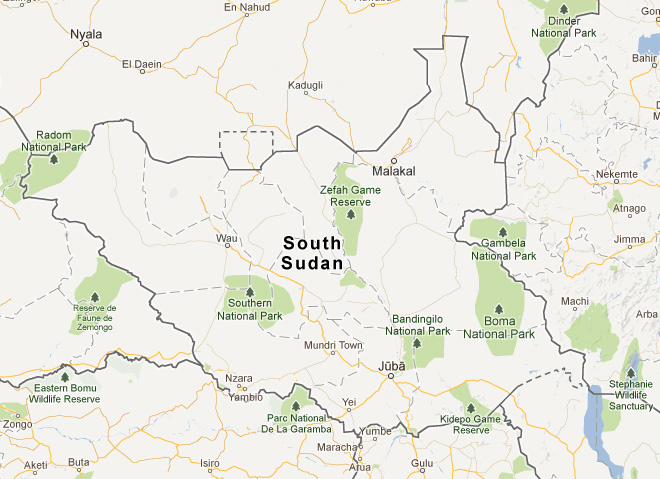

Poor and politically unstable country has been developed rapidly after independence of last year.
And the growth is expected in the future from all over the world.
On the other hand, you are able to encounter untouched great nature and pure tribes that has not been affected by civilization.
Especially “BOMA National Park” in Southern Sudan, the biggest migration takes place all year in this park.
Why do not you visit the youngest and most attractive country in the world?
Capital : Juba
Time difference : Greenwich Mean Time + 3H

If there’s a travel diamond in the rough of South Sudan it is Boma. The large, wild tract of land nearly adjoining the Ethiopian border was declared park in 1986.

With political peace and ecological care, though, Boma became one of Africa’s greatest wild treasure.
Boma National Park is 2,280,000 hectares (5,631,600 acres) in size.
After the Wildlife Conservation Society conducted a survey of the area they estimated that it was home to over 1.3 million white-eared kob; the movement of that species of antelope around Boma might constitute the world’s largest land animal migration! The Wildlife Conservation Society also found a surprising number of orstrich herds as well as elephants, lions, giraffes, eland, hippos and jackals.

As in northern Sudan and Egypt, the Nile River bisects southern Sudan and is the lifeblood of the country.
Time was that there were monkeys, hippos, crocodiles and other wildlife along the whole length of South Sudan’s stretch of the Nile.
Still, in villages along the Nile there’s something special about simply kicking back and taking in local’s life along the river?in many aspects it has changed little in the last century. Finding Nile wildlife away from people would be easy if travel conditions allowed.
For a little taste of South Sudan consider going to Nimule National Park.. Unfortunately, the park is not heavily populated by animals. But there is something charmingly undeveloped by it?the “nature trail” is a path through the shrubs knocked down by a hippo.

Juba is South Sudan’s capital and, with around 140,000 residents, by far its largest city. Most of South Sudan’s 60km of paved roads and virtually all of its government infrastructure are here.
Of primary interest to travelers would probably be Juba’s colorful markets, which buzz with the activity of merchants from Kenya, Uganda and DR Congo as well as from all around South Sudan.
Juba has a surprising number of restaurants and watering holes catering to the town’s large number of international aid workers; at a Juba pub you are much more likely to find yourself drinking Guinness next to a Dutchman watching a broadcast of the Manchester United game than you are to have any sort of local South Sudanese experience.

South Sudan is safer and easier to travel in than you probably imagine.
There are travelers of both the high-end and backpacker variety enjoying the country at this very moment.

[Egypt Airlines]
From Japan : Mon, Wed, Sat
NARITA 20:50 - CAIRO 03:50(+)
CAIRO 09:45 - JUBA 14:45
To Japan
Cairo Departure date: Tue, Fri, Sunday
JUBA 15:45 - CAIRO 18:45
CAIRO 23:20 - NARITA 18:00(+)
[Kenya Airways]
"KQ" has started daily flights from Nairobi to Juba offering onwards connections to the major destinations Worldwide from 7 June 2010. We were all there for the big launch, hosted by dignitaries including Mr Evanson Mwaniki, the Chairman of KQ and former Chairman of BAT.
[JetLink]
Two flights daily to Nairobi, one of the most used flights in and out of Juba. Office located in Paradise Hotel on the main street into Juba town.
mailto:sarah@jetlink.co.ke, www.jetlink.co.ke, +256 477113417, +249 955052413
[East African Safari Air Express]
Daily to Nairobi, a very popular airline in and out of Juba
[South Sudan Air Connection (SSAC)]
Flights to Bentiu and Yambio and other places in Southern Sudan
Location - Hai Suk
+ 256 129085473, info@ss-ac.net, www.ss-ac.com

Day 1: Arrive Juba, then transfer to HOTEL with assistant
Day 2: Full day, Juba City tour.
Day 3: Transfer to CAPOETA where native tribes lives by Vehicle (9hours)
Day 4: Transfer to BOMA National Park by Vehicle(5hours)
Day 5-6:Explorer Safari in BOMA Park. Then, visit house of Natives.
Day 7: Transfer to CAPOETA by coach
Day 8: Transfer to Juba by Vehicle.
Day 9: Transfer to Air Port with Guide. Departure from Juba.
Opened in June 2011. Beautiful and integrated hotel located in heart of Juba. Our office is located in this hotel.
http://jubaregencyhotels.com/
+211 955 506 070 reservation@jubaregencyhotels.com




One of the poshest places to stay. Well out of town, beautiful lawns and gardens.
Mundri Road | Gudele, Juba na, South Sudan
http://www.acaciavillage.com
+211905311056
This is one of the oldest, more established Hotel and camp that has kept modernizing.
Hai Malakal, alongside River Nile, Juba, South Sudan
http://www.afexgroup.com/camp_juba.php
jubabookings@afexgroup.com
Plot 86A, Block III | Korok, Juba 1000, South Sudan
http://www.korokguesthouse.com/
+211 954006899 info@korokguesthouse.com
Logali is the most exclusive place in Juba for accommodation.
High Marat, Juba, South Sudan
http://www.logalihouse.com/
+ 256 477 103 800 reservations@logalihouse.com
mailto: info@jskuwans.com
Tel: 81-3-5766-2310(Tokyo, Japan)
211-912919722 / 211-921444561(Juba, South Sudan)
